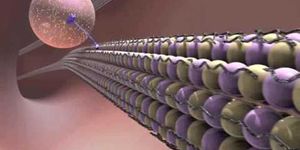Videos
Inside the Brain: Unraveling the Mystery of Alzheimer's Disease
FEB 13, 2014 12:00 AM PST
Share
How Genetic Adaptions May Help Polar Bears Stay Warm
 While you may know that polar bears adapt to their extremely cold environment, you probably don't know how they do it. New research points to certain genetic mechanisms as part of the answer.
While you may know that polar bears adapt to their extremely cold environment, you probably don't know how they do it. New research points to certain genetic mechanisms as part of the answer.A team led by researchers at the University of Buffalo discovered a potential genetic adaptation that gives polar bears an enhanced ability to live in the harsh environment of the Arctic. The team's work, partially funded by the National Fish and Wildlife Foundation, was published in a recent issue of Genome Biology and Evolution.
The current study is part of a longer-term program to study the overall adaptation of polar bears to the Arctic environment. Previous work involved genome sequencing of brown bears, black bears and polar bears, which led to the discovery of some genetic differences suspected to affect fat metabolism. By altering proteins that are a part of the fat metabolism process, these genetic differences may help to insulate the polar bear against its environment - a process that is not as important to black and brown bears.
The new study follows up by offering more insight into the environmentally beneficial genetic adaptations of polar bears. By studying the mitochondrial and nuclear genomes of 23 polar bears, and comparing them to corresponding genomes of black and brown bears, the team discovered a difference in genes related to production of nitric oxide. Nitric oxide also has a vital role to play in the metabolic process, and these gene functions were more pronounced in the polar bears as compared to their southern counterparts.
Generally, nutrients are consumed and converted by cells into energy. However, in certain situations, a process called adaptive thermogenesis results in the cells producing heat instead of energy. The team suspects that levels of nitric oxide may be one of the key factors in determining the conversion path that the cells take.
If so, polar bears may be adapting to their conditions through a genetic ability to tune nitric oxide production and shift their metabolism toward production of energy, production of heat, or the storage of insulating fat - whichever happens to be needed. This genetic difference would be logical, since brown and black bears have no need for this mechanism - they do not see such extreme conditions, and they hibernate to conserve their energy in the winter months.
This may also explain why Anana, the polar bear at Chicago's Lincoln Park Zoo, was moved inside during the recent polar vortex that produced record cold temperatures throughout the Midwest. Anana was lacking the thick blubber layer that she would have developed in the Arctic. It is hard to say whether differences in diet, a warmer environment, or both triggered the adaptation, but if the research team's findings are correct, the mechanism of the adaptation may be through Anana's manipulation of her intercellular nitric oxide levels.
By developing a greater understanding of how polar bears adapt to their environment, both in their native Arctic habitat and in different locations, we will have a better understanding of how polar bears will be able to adapt to continuing climate change - and perhaps how these adaptations affect the entire Arctic ecosystem.
You May Also Like
Loading Comments...








